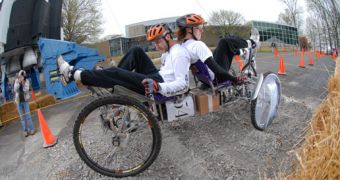Next year's early April will have NASA host the 16th yearly Great Moonbuggy Race, just the same as it did since 1994. This competition is addressed to high school and college teams (separately) that want to test how their technology skills would fare on the Moon. The winning condition is that a vehicle is the first one that crosses the end line, after traversing half of a mile-wide field that simulates the terrain conditions on the surface of the Moon.
The improvised transporter is required to be able to carry a crew of 2 people (one male and one female), and make it through the whole environment comprised of rocks, holes, "craters," "lava" ridges, slopes and lunar-like soil. And this is not all. The vehicle, dubbed "moonbuggy," must first be carried to the start point in a disassembled state, with its parts able to fit inside a 4 x 4 x 4 inches container, just like NASA's original Lunar Roving Vehicle.
Prior to the race start, the vehicle must be put together in the shortest time, which is eventually added to the actual racing time in a total time that would indicate the position of the team in the final general top. Furthermore, the 2 pilots of every moonbuggy must be chosen from its respective team of 6 builders. The high school teams will compete on April 3rd, while the college ones will test their prowess the following day.
The challenge addresses youngsters from all over the world, and this year there were 46 teams aligned at the start line, comprised of hundreds of students from the US, Canada, Germany, India and Puerto Rico. The vehicles entries don't have to be final concepts, but rather prototypes with "proof-of-concept" and engineering test features. Besides the 3 top best-time winners on each category (high school and college), other prizes include feats like team spirit, innovative design, or the rookie award.

 14 DAY TRIAL //
14 DAY TRIAL //